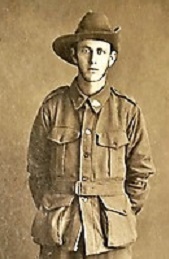
KENNETT, William
| Service Number: | 2938 |
|---|---|
| Enlisted: | 9 October 1916, Inverell, New South Wales |
| Last Rank: | Private |
| Last Unit: | 46th Infantry Battalion |
| Born: | Wallangra- Coolatai Area, New South Wales, Australia, 5 December 1892 |
| Home Town: | Tingha, Guyra, New South Wales |
| Schooling: | Not yet discovered |
| Occupation: | Miner |
| Died: | Killed in Action, "Tokio" Polygon Wood, Belgium, 1 October 1917, aged 24 years |
| Cemetery: |
No known grave - "Known Unto God" |
| Memorials: | Australian War Memorial Roll of Honour, Ypres (Menin Gate) Memorial |
World War 1 Service
| 9 Oct 1916: | Enlisted AIF WW1, Private, 2938, Inverell, New South Wales | |
|---|---|---|
| 10 Oct 1916: | Involvement AIF WW1, Private, 2938, 46th Infantry Battalion, Enlistment/Embarkation WW1, The 3rd Division was being assembled and trained on the Salisbury Plain in England, under Major General John Monash. Its first large scale operation would be the Battle of Messines in June 1917. | |
| 17 Nov 1916: | Embarked AIF WW1, Private, 2938, 46th Infantry Battalion, SS Port Napier | |
| 7 Jun 1917: | Involvement AIF WW1, Private, 2938, 46th Infantry Battalion, Battle of Messines | |
| 20 Sep 1917: | Involvement AIF WW1, Private, 2938, 46th Infantry Battalion, Menin Road | |
| 1 Oct 1917: | Involvement AIF WW1, Private, 2938, 46th Infantry Battalion, Polygon Wood |
Passchendaele War Museum
Additional information
William Kennett was born in 1892 in Coolatai, New South Wales. He was the son of John Kennett and Mary Ann Mitchell. He had three sisters and two brothers. Before he enlisted in the Australian Imperial Force he was a miner, like his father.
He enlisted in October 1916 and joined the 46th Battalion Australian Infantry, part of the 12th Brigade of the 4th Australian Division. The Division participated in the Battle of Polygon Wood, a phase of the Battle of Passchendaele. The attack started on the 26th of September 1917. The advance was to be carried out by the 4th and 13th Brigades of the 4th and the 5th Australian Divisions, while the 46th Battalion remained in reserve. William’s Battalion would not play a major role in the attacks until September 27th, when they moved into the frontline, between Tokio and Jabber House. The Broodseinde Ridge right in front of them.
The Battalion remained there, until the 1st of October 1917. “A” and “C” Companies were positioned in the front line, “D” Company was in close support and “B” Company was in reserve. The right half of the Battalion – near Jabber House - was relieved on the night of September 30th and October 1st. The left half – at Tokio - on the night of October 1st and 2nd of October 1917.
A diary entry from Private N. Pope, from the same Battalion as William, shows that on September 30th, 25 men of “B” Company were killed due to German shelling. On the 1st of October the 46th Battalion was heavily shelled for over two hours.
Twenty-Four year old William Kennett was killed on the 1st of October, while his Battalion held the line near Tokio. He has no known grave and is remembered on the Ypres (Menin Gate) Memorial, panel 27F.
Submitted 10 April 2020 by Greg Kennett
William Kennett
William was one of six children and the second son of John and Mary Kennett of Coolatai NSW. Although born in 1892, his birth was registered at Warialda the following year. When he enlisted at Inverell in October 1916 he was nearly twenty four years old and working as a Miner at Howell. William had previously been rejected due to his chest size. He had been a rifle club member for two years.
William was one of thirty two Inverell district men farewelled at a public function where they were presented with the Inverell Medal and a pair of socks. He joined the 46th Battalion, 7th Reinforcement and left Australia on SS Port Napier in November 1916. They arrived in England at the end of January 1917. Three months later he was sent to France and his Battalion took part in the Battle at Messines on 7 June.
Private William Kennett was Killed in Action on 1 October 1917 at Polygon Wood Belgium and has no known grave. A memorial service was held in his honor in November 1917 at the Anglican Church, Tingha. His name is inscribed on the Menin Gate Memorial, Ypres, Belgium. His few personal effects and War medals were sent to his Mother. William’s two cousins, Alf Gooda and George Cawkwell were also killed during the War.
Submitted 18 May 2018 by Greg Kennett















